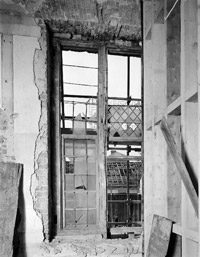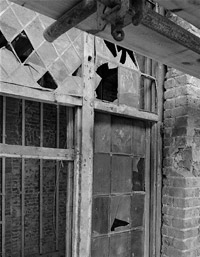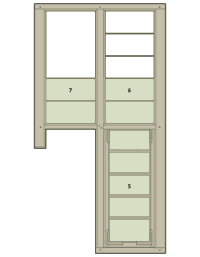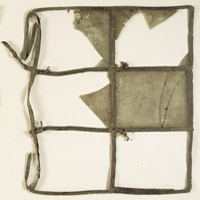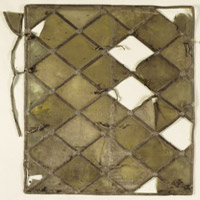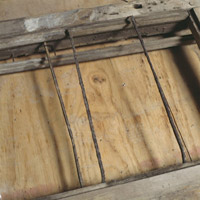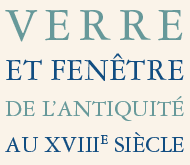∧ Back to topThe architectural setting
A long brick range with two pavilions, designed by William Samwell, was added to a property in Newmarket, Suffolk in 1671, just three years after it had been bought by King Charles II. The remains of this building are now known as Palace House Mansion. A partly-glazed window frame was discovered in one of the pavilions during restoration work in 1996-97 (Fig 1). Because of subsequent alterations, part of the window had been cut away by the early 18th century. The rest had only survived because it had been sealed behind new brickwork during further alterations in the 19th century1.
∧ Back to topThe window frame
The frame measured 2.75 × 1.5 m and was made of oak (Fig 2). The glazing in the upper half of the window was fixed, but the two lower quarters were rising sashes, only one of which survives. These were counterbalanced on one side only by three cylindrical lead weights (100 × 38 mm) which were strung on the sash cord, a tube of tightly-woven flax fibres (Linum usitatissimum L.) (Fig 3). The cord ran over a wooden pulley-wheel and the weights travelled in a bored hole in the solid outer frame.
∧ Back to topThe glazing

Fig. 4: The lead weights and fragment of sash cord.

Fig. 5: The inside of the glazed panel from the rising sash.
Three glazed panels were found. The largest (1.25 × 0.46 m) is from the rising sash and is made up of rectangular panes set in lead cames, the central ones being 240 x 180 mm (Fig 4). Part of a panel of fixed glazing (0.58 × 0.51 m) came from above the sash (Figs 1 and 5). From above the lost sash, is another fixed panel (0.58 × 0.51 m) of leaded diamond-shaped panes, each 140 x 110 mm (Figs 1 and 6).
The panel with diamond-shaped panes was part of the original glazing scheme which was blocked off when the sash below it was cut away to make a doorway. It was held back to iron glazing bars (Fig 7), and to nails in each corner, by lead ties. There is no surviving putty.
The other half of the window appears to have remained in use and was reglazed with panels made of rectangular panes, possibly when alterations were made before early in the 18th century. The fixed panel was also tied back to iron bars, while that in the rising sash was tied to moulded horizontal wooden bars (Fig 8). There is no putty, but occasional tacks help hold the panels in place, as do the L-shaped iron brackets at the bottom corners of the rising sash (Fig 2).
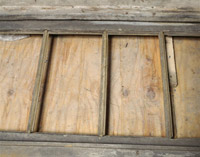
Fig. 9: Wooden glazing bars in the rising sash.
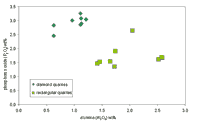
Fig. 10: Analytical data for the glass panes.
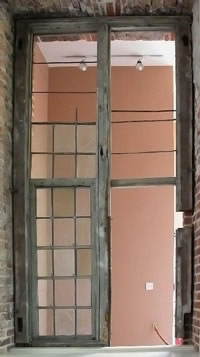
Fig. 11: The window frame from the inside, after conservation.
∧ Back to topThe glass
All the panes have a range of pale greenish tints and appear to be cut from slightly bubbly cylinder-blown glass. Analyses were made of samples from eight of the diamond-shaped panes and from nine of the rectangular panes from the fixed panel. All the glass has a high-lime low-alkali (HLLA) composition, though there are small differences between the diamond and rectangular panes (Fig 9) and some variation between panes of the same shape. These differences may be due to the use of glass from different production sites or may reflect differences in date.
∧ Back to topDiscussion
HLLA window glass was common in England from the last quarter of the 16th century but by about 1700 mixed alkali glass with a high strontium content (indicating the use of seaweed as a flux) was used instead. The Palace House Mansion window is thus a late example of the use of HLLA glass.
Other surviving 17th-century sash windows in England all date to c. 1687-90 or later, so the Newmarket window appears to be the earliest, though there are documentary references to sash windows at Whitehall Palace in London (now destroyed) in 1662. Sash windows are known to have been used in France from c. 1630, with a surviving example in Troyes believed to have been made in 16602.
∧ Back to topAcknowledgements
The glass was analysed by Roger Doonan, who also examined the lead weights. The fibres of the sash cord were identified by Penelope Walton Rogers. Figs 1 and 2 are © Crown Copyright NMR. Figs 3, 4 and 11 are all © English Heritage. Figs 5-9 are all © English Heritage Photo Library.

